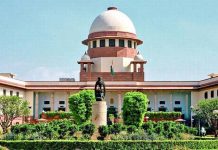
It was over 17 years ago when Lalu Prasad Yadav was first named in the “fodder scam”, the popular name for an embezzlement of Rs 950 crore (Rs 2,000 crore at today’s value) of government funds meant to buy food and medicines for livestock. As the fraud took place in the 1990s when Yadav was Bihar’s chief minister, he was accused of protecting the scammers who gave forged receipts for fodder and medicines never bought. In these long years, while the trial in the criminal case for the embezzlement moved at a snail’s space, Yadav rode to the top of his political career and crashed to its bottom too.
After formal charges in the case forced him to resign as CM in July 1997, Yadav shockingly replaced himself with his homemaker wife, Rabri Devi, the mother of his nine children. He thus continued to rule as the de facto power. Despite the wide outrage at this subversion of democratic principles, his Rashtriya Janata Dal (RJD) thumped to a win in the 2000 assembly elections. Four years later, he won a whopping 24 Lok Sabha seats, becoming a kingmaker that saw the Congress, once his archenemy, seize New Delhi. Yadav would go on to be India’s most famous railway minister, turning the railways around and lecturing business school students on how to make the public sector profitable.
Then came the fall. In 2005, the RJD stunningly lost the state after 15 years, whipped for criminalising politics and society and for failing to bring development. In the 2009 Lok Sabha elections, the RJD was nearly wiped out, winning only four of the state’s 40 seats. Yadav humiliatingly lost one of the two seats he contested. At the 2010 state elections, the RJD performed even worse than it had in 2005. His wife lost both seats she fought on.
And now he is in jail. Does today’s ruling, by a judge in Ranchi city of neighbouring Jharkhand state, that Yadav is guilty in the case mark the end of his career? Or will it become his vehicle to ride back to power by making him a martyr with the state’s backward castes, to which he belongs and who number some two in five of Bihar’s electorate?
Both answers can be affirmative depending on an assessment of his current political relevance and abilities. If you believe Yadav is still the magician from the past with his core USP intact, the jailing would consolidate his backward votes at next year’s Lok Sabha elections ending an eight-year rough patch. He may then realistically dream of returning to power in the state too in the 2015 elections. But if you think the factors that pitchforked him to the fore of Bihar’s and national politics a quarter century ago are passé, like bell-bottoms, tape-recorders and child marriage, then his jailing would hardly move voters.
Of course, it may be hasty to suggest the last word from the judges has been heard. Yadav will certainly appeal the conviction at the high court where he will argue that there is no evidence of his direct involvement. Abdul Bari Siddiqui, an RJD leader who is the Leader of the Opposition in the Bihar state assembly, told this reporter last month in Patna that the only role Yadav is accused of is that he extended by a year the service of a state official named Shyam Bihari Sinha who headed the animal husbandry department, the nodal agency where the scam occurred. Sinha, the prime accused, later died in judicial custody.
Yadav’s aides think a martyr’s halo would make a good situation better. They reckon the Bharatiya Janata Party’s (BJP) split from Bihar’s ruling Janata Dal (United) in June has in two ways improved the RJD’s chances to repossess the top political slot. One, the coalition of the upper castes, who’re the BJP’s mainstay, and the backward castes, who the JD(U) brought to that union, has now broken. And two, anti-incumbency of the last eight years would go against both the JD(U) and the BJP, which was in government until June.
Be that as it may, there is no denying that Yadav’s political reality today is substantially different than what it was in the 1990s when the fodder scam made him toxic for all other parties, which led him to split what was until then the Janata Dal to form his own party. (Ironically, in the years the fodder scam’s taint stuck to his chest, he stayed on top of his career. His jailing comes when few remember the fraud or his involvement in it.)
For one, scam or no scam, Lalu was the tallest politician in Bihar throughout the 1990s despite the existence of many national-level leaders from the state. That began to change after his one-time-protégé-turned-rival Nitish Kumar became chief minister in October 2005. Today, Kumar is perceived to have dramatically slashed crime and launched schemes to help the disadvantaged in the backward castes, the Dalits and the Muslims, forcefully carving out a slot for himself as a latter-day social engineer and messiah. Reinforcing that impression, Kumar convincingly won reelection in 2010.
Although Kumar, too, continues to face criticism, especially over rampant corruption, he has the meat to stall Yadav’s revival. Importantly, the mantle of a champion of the backwards castes and the poor that Kumar claims for himself is exactly the mantle that Yadav gave himself to emerge as the state’s chief minister for the first time in 1990.
Unarguably one of India’s most trailblazing politicians of the last three decades, Yadav is correctly credited with irrevocably changing the power dynamics in Bihar. Before his spectacular rise, the upper castes, who are some 12 percent of Bihar’s 100 million people, sat atop the caste-based coalitions that ruled Bihar, mostly through the Congress party. Yadav reversed that. Today, not only do backward and lower castes top the ranks in every political party, they also dictate and direct the political agenda. Indeed, Kumar would never have become chief minister had Yadav not altered the basic DNA of Bihar’s politics.
Yadav’s other enormously significant success lay in containing the virus of Hindu communalism that swept nearly every state in north and central India in the late 1980s and through much of the 1990s in the wake of the BJP-led movement to replace the 16th-century Babri mosque at Ayodhya town in Uttar Pradesh with a Hindu temple. Just a few months after becoming CM, Yadav famously arrested BJP leader LK Advani when his multi-state roadshow, which aimed to build support for the temple, reached Bihar.
In the 1991 Lok Sabha elections following Advani’s campaign, which made the Ayodhya issue a top electoral agenda, the BJP performed phenomenally well in the north and central states of UP, Rajasthan, Madhya Pradesh, Gujarat and Himachal Pradesh. Except in Bihar, where it won only five seats, all of them in the part that became Jharkhand a decade later, and none of the 40 seats that today constitute Bihar. Yadav successfully established the supremacy of caste politics so much so that the BJP could never make Hindutva rouse passions. Falling eventually in line with the caste politics, the BJP’s electoral successes have come only in a coalition with the JD(U) or its earlier versions.
That’s why the RJD thinks the BJP-JD(U) split would work to its advantage. Hence the party will make every attempt to paint Yadav’s conviction as a conspiracy aimed at maligning his reputation. Don’t be surprised if his wife and children, led by his eldest daughter and one or two sons, hit the road with a sob story as their primary calling card.
But will it work? Once again, Yadav’s and the RJD’s fates will be determined by Bihar’s Muslims, who are 18 percent of the population and have the potential to swing the election away from or towards him, regardless of his incarceration for corruption. Yadav had built his fortunes on the back of a solid coalition of Muslims and Yadavs, plus other backward castes. But CM Kumar has emerged as a rival claimant to the votes of the backwards.
For the Muslims, the top priority is to defeat the BJP, especially since it has chosen as its prime ministerial candidate Gujarat CM Narendra Modi, who the Muslims blame for the massacre of some 2,000 of their brethren over 11 years ago in Gujarat. Going constituency-wise in Bihar, the Muslims would vote for the candidate who appears strongest to defeat the BJP’s at the next Lok Sabha elections due in May.
This may be tricky for Yadav. If a JD(U) candidate seems like a winner in a constituency, the Muslims would not hesitate to back him. In order to gain Muslims’ votes, Yadav would need to ensure that the backward castes desert the chief minister in large numbers and flock to the RJD. Yadav can hardly hope to achieve that by targeting Kumar’s track record, which has certainly been better than the 15 years of the Yadav husband-wife misrule.
Yadav’s only hope lies in successfully projecting his conviction and jailing in the fodder scam as an injustice to him and his caste brethren by claiming that he’s been targeted as he empowered the backward castes socially and politically. However, should this pitch fail, Yadav may well be looking at political oblivion forever besides, of course, a long stretch in prison.












